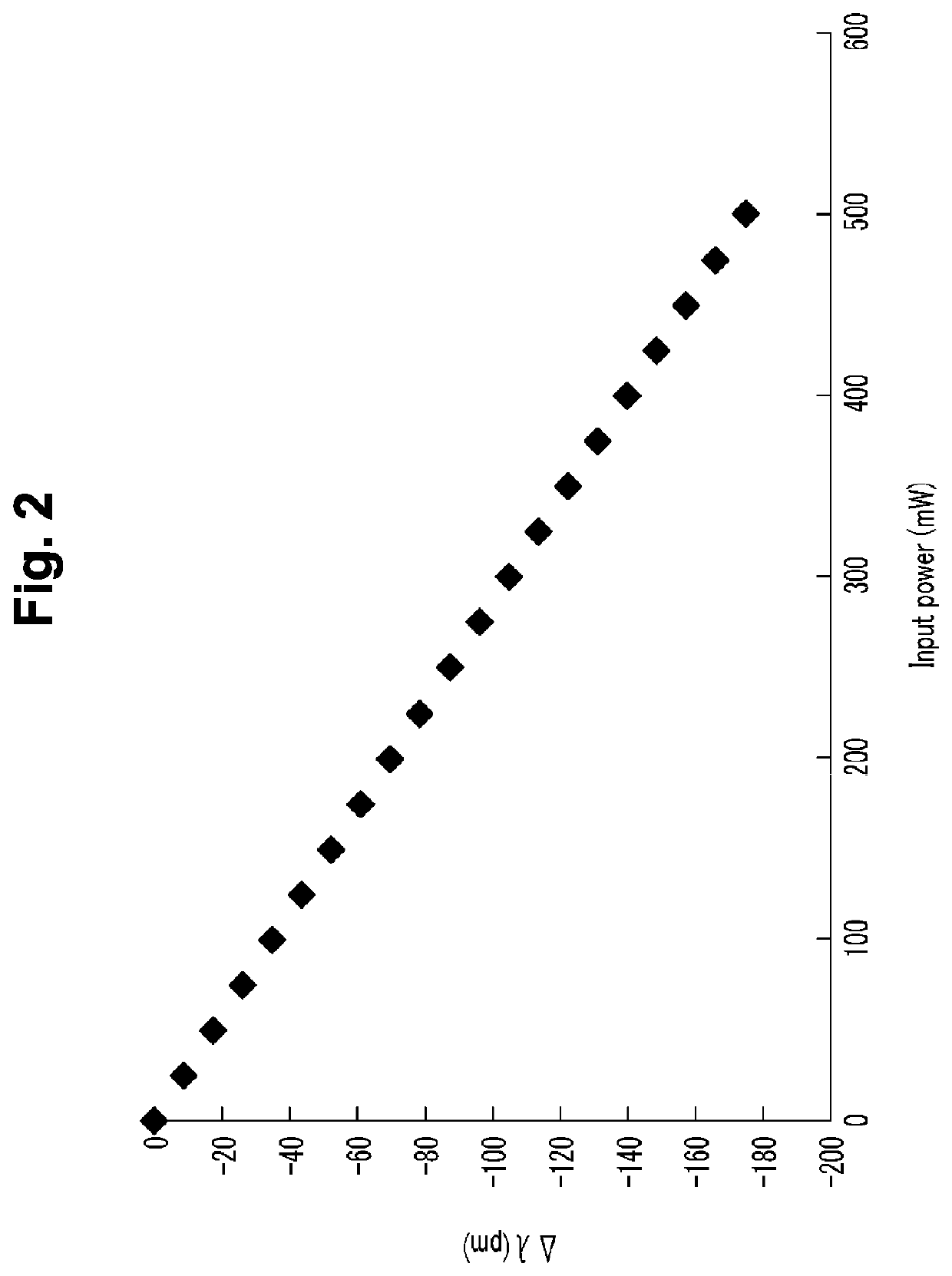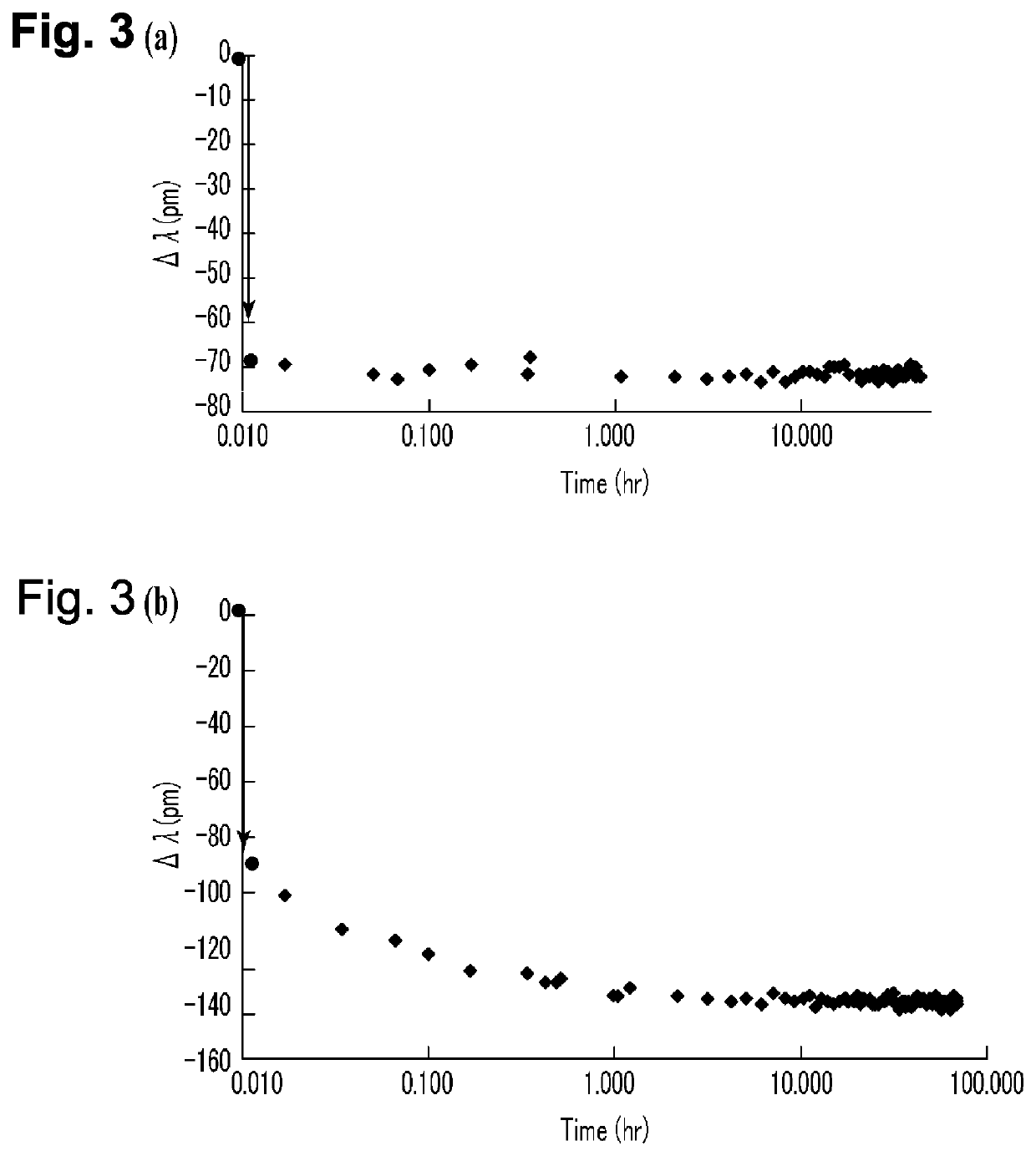Filling Resin and Optical Waveguide Circuit Filled with Filling Resin
a technology of filling resin and filling resin, which is applied in the field of optical communication using optical fibers and waveguides, can solve the problems of shortening of resonance wavelength or diffraction wavelength, increasing loss, etc., and achieves the effect of constant wavelength
- Summary
- Abstract
- Description
- Claims
- Application Information
AI Technical Summary
Benefits of technology
Problems solved by technology
Method used
Image
Examples
example 1
[0040]In the present example, an example will be shown where the following filling resin is applied into the waveguide groove of the optical waveguide circuit. Dimethyl silicone gels KE1056 (refractive index nD(25° C.)=1.414), KLE1055 (refractive index nD(25° C.)=1.426) made of Shin-Etsu Silicone have a refractive index difference of 0.012, and FIG. 4 shows the results of changes (instantaneous change and change over time) in wavelength upon input of high power at the time of filling with a resin obtained by mixing the above gels at 1:1. The dimethyl silicone gels KE1056, KLE1055 can be mixed because the refractive index difference therebetween is within 0.04. When a high power of 200 mW is applied, the wavelength shifts to a shorter wave by −75 pm instantaneously (within ten seconds), but thereafter, the wavelength returns to positive by 12 pm in about ten minutes to one hour. In the case of each of the silicone gels KE1056, KE1055, a catalyst and a thermosetting agent are containe...
example 2
[0042]In the present example, an example will be shown where the following filling resin is applied into the waveguide groove of the optical waveguide circuit. The waveguide groove is filled with fluorine silicone gel X71-8115 (refractive index nD(25° C.)=1.30-1.33) manufactured by Shin-Etsu Chemical Co., Ltd. FIG. 5 shows the results. The fluorine gel has low absorption (loss of 0.1 dB / cm) at a wavelength of 1550 nm, and therefore, even when high power is input, the temperature rise is small and the instantaneous change is small. On the other hand, in the case of filling with fluorine silicone gel X71-8115, when a high power of 200 mW was input, the wavelength instantaneously shifted by −12 pm. Thereafter, the wavelength returned to about 8 pm in about ten hours. This means that the wavelength has returned by about 30%.
[0043]In the present example, the filling resin in the waveguide groove has been described, but the filling resin used in the present example is also applicable betw...
example 3
[0044]In the present example, an example will be shown where the following filling resin is applied into the waveguide groove of the optical waveguide circuit. Upon curing of silicone KER 6200 (refractive index nD(25° C.)=1.500), 5% of phthalate ester dioctyl phthalate (DOP) was added. Phthalate ester DOP is compatible with silicone and can be mixed uniformly. The refractive index of DOP is 1.485 being lower than that of KER 6200, and when high power is input, this DOP diffuses from the light passing portion to the periphery, so that the refractive index of the portion through which light passes increases. Hence the temperature rises instantaneously upon input of high power and the wavelength shifts to a shorter wave by about −50 pm, but thereafter, the wavelength returns to the original value due to the diffusion of DOP. Many various plasticizers have been developed as shown in Table 1 described above, and it is possible to find therefrom the optimum combination of the silicone mat...
PUM
| Property | Measurement | Unit |
|---|---|---|
| refractive index | aaaaa | aaaaa |
| power | aaaaa | aaaaa |
| refractive indices | aaaaa | aaaaa |
Abstract
Description
Claims
Application Information
 Login to View More
Login to View More - R&D
- Intellectual Property
- Life Sciences
- Materials
- Tech Scout
- Unparalleled Data Quality
- Higher Quality Content
- 60% Fewer Hallucinations
Browse by: Latest US Patents, China's latest patents, Technical Efficacy Thesaurus, Application Domain, Technology Topic, Popular Technical Reports.
© 2025 PatSnap. All rights reserved.Legal|Privacy policy|Modern Slavery Act Transparency Statement|Sitemap|About US| Contact US: help@patsnap.com



